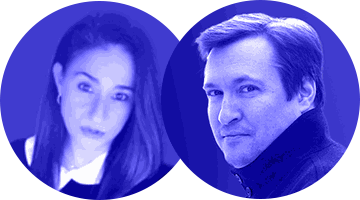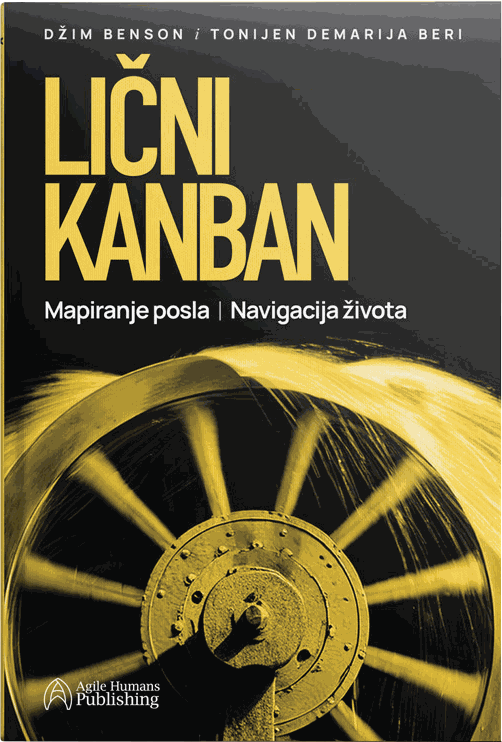The Essence of Personal Kanban
A Conversation with Jim Benson and Tonianne DeMaria Barry
Celebration of 7th AGILE HUMANS® day


“For us, the essence of Personal Kanban lies in creating an environment where people feel good and secure at work, fostering a sense of connection with their job and colleagues,” say Jim Benson and Tonianne DeMaria Barry, widely recognized as global authorities on Personal Kanban. For over 20 years, this dynamic duo has been training individuals and diverse teams—ranging from government agencies and private corporations to banks and restaurants—on how to create effective Kanban boards.
Jim and Tonianne are also the authors of Personal Kanban: Mapping Work | Navigating Life, published in Serbian by Agile Humans Publishing. In a recent online lecture organized by Agile Humans, they shared practical examples of Personal Kanban's advantages at home and work. They explained whether three simple columns—Ready, In Progress, and Done—are sufficient, dissected common mistakes in team collaboration, and discussed how to achieve significant performance metrics. This interview is an adaptation of their conversation with both the local and international Agile communities.
What Is Personal Kanban? Why Is the Book Subtitled "Mapping Work, Navigating Life"?
Jim: Personal Kanban is a visual tool for managing work. It applies Kanban principles to individual and team productivity, built on two core concepts: visualizing your tasks and limiting your work in progress (WIP).
Everyone has expectations—whether self-imposed or from colleagues, spouses, or friends. If these tasks aren’t documented and organized, there’s a higher chance we’ll forget to do them. The goal of Kanban is to prioritize effectively.
When I ran my software company, we used Agile practices, holding daily stand-ups where everyone shared what they had done the previous day, what they were working on, and any blockers. Over time, I realized this approach was flawed—people could say whatever they wanted. So, I asked my developers: “Did you complete what you mentioned yesterday? What about the tasks from two or three days ago?” Their responses were often excuses.
To address this, I introduced a whiteboard where we listed unfinished tasks and planned activities for the day. Although they initially resisted, once they focused on tasks from the board, they completed them efficiently.
Start by taking the overwhelming list of tasks that cause stress and fear and breaking it down. Place a few key tasks into the first column and arrange them as sticky notes or square cards. This spatial organization helps your brain process them by establishing relationships of priority and importance. From there, decide which two tasks are the most critical to complete today. The key to the In Progress column is limiting WIP—no more than two or three tasks at a time. This principle is also used by Scrum teams to maintain focus.
By adopting this approach, managers gain visibility into what’s important to you and what’s in your backlog. They can also add urgent items to your board as needed.
How Do We Choose the Most Important Tasks from a Long List?
Jim: This is where prioritization filters come in—P1, P2, P3 (Priority 1, 2, 3). Only three high-priority tasks go into P1, a few more into P2, and less critical ones into P3. Reviewing this prioritized list helps you determine what’s truly feasible. For instance, you might realize you can’t proceed with a task because Tonianne isn’t available, or another task depends on a different team’s priorities. Once you identify a doable task, move it to the In Progress column.
These filters aren’t static; they require constant reevaluation to reflect changes in your workload and realistic capacities.
Should We Start with a Physical Board or Digital Tools?
Tonianne: Personal Kanban has only two rules: visualize your work and limit WIP. Skipping either rule will hinder progress. To begin, a simple whiteboard and sticky notes are sufficient until you develop the habit and transition to digital tools. Initially, our book introduced the columns Ready, Doing, and Done, but over time, we suggested alternative labels like Options, as language shapes behavior. For example, labeling a column To Do implies obligation, creating reluctance to remove tasks based on context.
I recommend starting with small personal projects, like organizing a New Year’s Eve party, to practice Kanban principles.
Jim: A Kanban board’s primary function is to provide actionable information. You want to know what’s pending, what you’ve learned, and how completed tasks have influenced your workflow. Adding columns like Retrospective enables ongoing reflection and adaptation. Every Kanban board is unique—some are compact, while others resemble sprawling white sheets, depending on the project.
How Can We Prevent People from Rushing Tasks to Impress Their Boss?
Jim: In software, people often have different learning styles and focus preferences. Some focus on minor details and overlook the big picture, while others do the opposite. Neither approach ensures quality completion. Personal Kanban is about ensuring that when a task moves to Done, it doesn’t reappear because of poor execution. This redefines quality as tasks genuinely completed without recurring issues.
If a task lingers too long on the board, the root cause is structural—poor organization or an inadequate problem-solving approach. Addressing this requires systemic changes, not just quick fixes.
Tonianne: At a bank we worked with, we added a Retrospective column with happy and sad emoticons. Employees rated tasks upon completion, and if a task received multiple sad faces, they immediately convened a meeting to identify the issues. Questions included: Were deadlines too tight? Were resources insufficient? Some teams even adopted a rule: a task isn’t marked Done until peers agree it meets quality standards.
Can Personal Kanban Be Applied at Home?
Tonianne: Our next book, Kidsban, will address this. For example, if you ask your kids to clean the yard, they might say it’s done when it’s not up to your standards. Establishing clear expectations for what Done means is essential.
What’s the Unexpected Emotional Benefit of Personal Kanban?
Tonianne: Studies show moving a task to Done triggers positive feelings. It’s not just visual recognition of success; completing tasks releases serotonin and dopamine, providing a neurological reward. However, if tasks are too large, they can overwhelm the brain. Break tasks into smaller, manageable pieces to maintain motivation and satisfaction.
Personal Kanban fosters collaboration and mutual support. For example, if I notice a colleague struggling with a task on their board, I can say, “Let’s pair up and solve this together.” This system enables seamless collaboration without unnecessary questions.
Kanban also helps form habits. I’ve used it to track goals like reading 52 books a year or exercising regularly, and it’s helped me succeed. It even improves my relationship with my partner by visualizing and appreciating each other’s contributions.
When Does Kanban Fail?
Tonianne: Kanban isn’t about tracking every possible task. Overloading your board can lead to anxiety, as we’ve seen with some users. For example, one woman tracked every grocery item as a separate card—clearly unnecessary. Rapidly moving cards often signals tasks that don’t belong on the board.
What’s the Most Important Lesson You’ve Learned Teaching Kanban?
Jim: Every person wants to be a good professional. Helping people understand their work empowers them to achieve that.
Tonianne: Once, we were working with a large insurance company, and we asked the employees what they wanted to achieve by the end of the week. A woman stood up, trembling, a mother of three teenagers, and said, "I have to succeed in this job. Please help me prove to my boss the purpose of my existence in this company." I’m an impulsive Italian, and I almost broke down right there. I managed to hold myself together, but since then, I’ve been telling this story. We spoke to her managers, who allegedly didn’t know how she felt, but they didn’t even know her name, and she had been working there for 19 years. For me, the most important lesson is that the true measure of an organization’s health isn’t the metrics, but creating space for people who have been there for decades and feel as if no one sees them. Personal Kanban helps to make their efforts visible. We are overwhelmed with various demands and challenges, not only at work but also at home, in the country we live in, and even globally. If we make life easier for people who work 10 hours a day, they will go home more satisfied and may become better partners and citizens.
Find clarity in the chaos—get your copy of Personal Kanban, which we translated into Serbian, and bring flow to your work and life.
